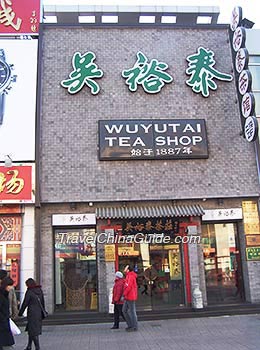Tea Culture
 |
| Exquisite tea wares |
The Chinese have a saying: 'Firewood, rice, oil, salt, sauce, vinegar and tea are the seven necessities to begin a day.' Though tea is last on the list, we still can see its importance in daily life.
A simple meal in Chinese is Cu Cha Dan Fan, namely coarse tea and tasteless dinner. Even a simple meal is finished off with tea so its importance is obvious.
For the Chinese, tea drinking and tasting are not the same. Tea drinking is for refreshment and tonic effect.
Tea tasting has cultural meaning. Tea and tea sets should match surrounding elements such as breeze, bright moon, pines, bamboo, plums and snow. All these show the ultimate goal of Chinese culture: the harmonious unity of human beings with nature.
Tea is compared to personal character. Its fragrance is not aggressive; it is pleasant, low-keyed and lasting. A friendship between gentlemen is also like a cup of tea. With a cup of tea in hand, enjoying the green leaves in a white porcelain cup, you will feel peace. Fame, wealth and other earthly concerns are far away. It is the symbol of elegance.
 |
| Tea shows |
Aside from mention in specific how-to books, tea is frequently discussed in poems and novels and appears in paintings.
In The Dream of the Red Chamber, one of four ancient Chinese classic novels, the author, Cao Xueqin revealed his knowledge of and insight into tea, as well as his knowledge of the tea-drinking customs of the Qing Dynasty.
People of varying ages or status had tea made with different water in various wares. Miao Yu, a nun in the novel, treated aristocratic friends with either well-preserved rainwater from the previous summer or with snow water collected from snow on plum blossoms! This tasteful interest was a privilege of the past when the air was free of pollutants.
We also find from the novel that Thai tea was imported to China and enjoyed by the rich. One of the heroines from the wealthiest family in the city was bold enough to dislike this ; the rebellious hero also made negative comments about the tea. Maybe it had less to do with the its taste than with their psychological makeup.
Tea is a mysterious but harmonious combination; it is spiritual as well as material, and invigorating as well as pacifying. Its character is flexible in different environments. For example, as it goes in a different direction, a different tea culture is formed. In Japan, the rigorous tea ceremony reflects the nation's character of making full use of every resource, while tea also represents peace of mind. In the West, tea with sugar and milk may be served with desserts to create a leisurely and romantic atmosphere.
Similarly, tea-drinking habits vary in different parts of China. Roughly, scented tea is popular in northern China; green tea is preferred in eastern China, and black tea is optimum for people in Fujian and Guangdong.
Notably, Yum Cha (tea drinking) is very popular in Hong Kong and Guangdong Province. Though dim sum, the true highlight of Yum Cha, is what attracts gourmets, tea is an essential part of the meal.
|
|
Tea Ceremony

